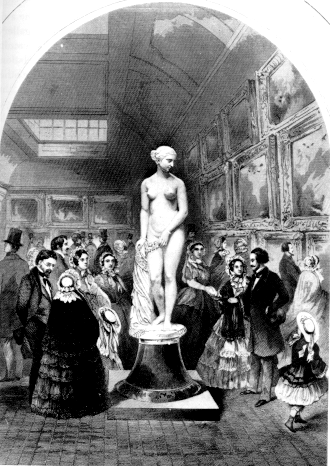The most famous American statue of the 19th century depicts a naked Greek slave. It was an innovative work of art that provoked reactions from the first moment, but in the end, it was much loved.
Hiram Powers is considered one of the greatest American sculptors of all time. Born in 1805, the American artist inscribed himself in the neoclassical school. He deeply admired Greco-Roman culture and drew inspiration from ancient sculptors. In fact, in 1837 he decided to move permanently to Florence.
At that time, the situation in post-revolutionary Greece was still turbulent and the bloody memories of the struggle were still fresh. Greek-Turkish conflicts had not ceased, while Greeks living in unredeemed territories suffered under the Turkish yoke. Powers had constantly followed the development of the Greek revolution through the news that reached his homeland. The heroic struggles of the Greeks had moved him, and this was a source of inspiration.
So close to Greek reality, in 1843 he began carving the statue that would go down in history as his most important work. The "Greek Slave" represents a naked young woman, with chains in her hands. Between her bonds she holds a small cross, while at the same time resting on a colonnade.
According to Powers: "The Turks abducted the slave girl from a Greek island during the Greek Revolution. Her father, mother, and possibly all her relatives had been exterminated by the enemy. She herself was kept alive as valuable war booty. Now she finds herself among barbaric strangers and has the misfortune of remembering every detail of the catastrophic events that brought her to this situation. She is exposed to the eyes of people she hates and awaits her fate with great fear, tempered by her faith in the goodness of God. Take all these sufferings together and add to them the strength and obedience that a Christian feels. There is no room for shame."
The sculpture of Hiram Powers is an amalgamation of ancient and modern Greek history. The symbolism behind "Greek Slave" comes from the national liberation struggles and the sufferings that the Greeks - contemporaries of Powers - endured at the hands of the Turks. At the same time, the style is very reminiscent of well-known ancient Greek statues of the Hellenistic period, such as the Aphrodite of Cnidus and the Aphrodite of Medici. The artist tried to unite the present and the past to make his message ring louder.
When Hiram Powers first exhibited the "Greek Slave", public opinion was not very enthusiastic. The image of absolute nudity alienated the people of his time, who tended to identify the naked with the obscene. Artists avoided depicting revealing scenes that might shock viewers. For this reason, Powers was considered a pioneer. The "Greek Slave" was the first statue by an American sculptor to depict a woman in normal dimensions and without any clothing.
Prominent collectors asked Hiram Powers to sell them copies of The Slave. The original work was made of clay. So in 1844 Powers' workshop produced the first replica in marble. Five more marble sculptures followed, identical to the original. Today, all six are extant. They are on display in prominent places in major museums around the world, such as the National Gallery in Washington, the "Smithsonian American Art Museum" and the medieval castle "Raby" in the north of England.












